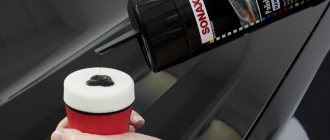Humidity in the car causes the windows to fog up, reduces visibility and increases the risk of accidents. With these tips, you are guaranteed to dry out your car from the inside.
Every car enthusiast is familiar with the problem of glass fogging. In cold and “wet” seasons, windows fog up quite quickly, since cold air contains more moisture than warm air.
It is especially noticeable in winter, when moisture enters the car through clothes and shoes, and then condenses on cold windows. The liquid settles on the boundary between heat and cold - the glass, creating a thin film of water on it, due to which nothing is visible.
Apart from physics, there is another reason: the car is not well maintained. However, with the right approach, the problem can be quickly resolved. Therefore, it is better to start preparing for the winter season in advance - check everything so that you do not experience any difficulties in winter.
Let's make a reservation that the tips listed below are not a panacea for all ills. First you need to understand the root cause of high humidity - if the sunroof of a car is leaking, then simple drying will not help, only replacing the seal, etc.
We advise you to read our articles
[su_custom_gallery source="taxonomy: post_tag/1217,1231" limit="2" link="post" target="blank" width="290" height="290" title="always"]
Forced ventilation against humidity in the car interior
Any car has technological openings for ventilation. They are usually located in the trunk or floor of the car.
As a rule, the holes are quite small, so they often become clogged or completely covered with something. It is imperative to monitor the forced ventilation system. Otherwise, moisture will not be able to flow out of the cabin and will condense on the windows.
Silica gel
This is a granular synthetic material that has gained popularity for its absorbent properties. It is actively used in a variety of areas - from logistics to storage of clothing and shoes, grocery products and other materials. It is perfect for eliminating excess moisture in the cabin.
It is enough to pour the required amount of transparent granules onto the problem area and wait until they absorb the liquid. The material is fireproof, does not harm humans and animals, and does not emit any hazardous substances during storage.
Silica gel perfectly absorbs moisture not only from the surface, but also from the air. For comfortable use, it is poured into a container, which is left in the car overnight. Silica gel can also be packaged in small bags, poured into gauze, old stockings or socks.
Dehumidifier against humidity in the car interior
With the development of technology, drivers began to have new gadgets that make life easier. Let's turn to them.
Reusable “drying pads” are now being sold. They intensively absorb moisture from the air and contain it within themselves. Once the desiccant is full, it can be dried in the microwave or on a heater. Quite a useful thing; the wider selection ensures that the pillow fits into the interior design. The cost of such a thing starts from 200 rubles.
We advise you to read our articles
[su_cust[su_custom_gallery source=»posts: recent» limit=»3" link=»post» target=»blank» width=»190" height=»190" title=»always»]>And so that for sure
Drying without disassembling the interior does not guarantee 100% results. The fact is that soundproofing material has properties different from carpet. It resists getting wet, but when wet, it is reluctant to give up moisture, as ordinary fabrics and carpets do.
Drying the Shumka separately from the car repeatedly confirms this fact. Thus, the duration of drying a “sandwich” using fan heaters is about four days. However, the result is obvious: the material becomes completely dry, which is what is needed.
In summary, we emphasize that the best way to dry the car interior from water is to completely dismantle the carpet and sound insulation, followed by active drying with heaters. This is how you can guarantee the drying of the “sandwich”, that is, avoid the appearance of pockets of corrosion inside the machine.
Caring for seals against moisture in the car interior
Over time, all rubber products “dry out” and lose their original properties. Seals are no exception.
Lubricate all seals on doors, windows and hatches regularly. If they are porous, torn and do not fit tightly, then water can penetrate into the interior without any problems. It is worth treating them with silicone grease, it is not expensive - from 250 rubles, but it lasts for a long time + the car’s seals will be “like new”.
Toilet paper
Toilet paper or paper towels have helped housewives more than once when it was necessary to quickly collect spilled liquid. Drivers will also find it useful to keep the car interior dry.
The method is effective when moisture has accumulated in certain places. Cleaning can be quite inexpensive if you buy the cheapest paper. It won't completely eliminate moisture, but it will prevent you and your passengers from getting your feet wet and causing water to spread further throughout the cabin. It is convenient to use toilet paper when you need to leave for work in the morning, but there is no time for a full cleaning.
Cleaning gutters against moisture in the car interior
Clogged door drains are the leading cause of moisture in your car. As a rule, they are clean within the first two years after the car leaves the assembly line.
Then time takes its toll and without proper care, these gutters become clogged. To clean them, you should take a piece of steel wire of a suitable diameter and simply clean the gutter. Usually the drainage hole is located at the bottom of the door under the seal.
We advise you to read our articles
[su_custom_gal[su_custom_gallery source=»taxonomy: post_tag/1598,1100" limit="2" link="post" target="blank" width="290" height="290" title="always"]actions with heavy moisture gender
In case of more global flooding of the interior, for example, when the car has scooped up water from a deep puddle or dived into a body of water, the problem cannot be solved by the methods discussed. If you can drain the main water yourself, then for complete drying it is better to use the services of professionals, since in this case you cannot hesitate. The longer the interior is in contact with water, the higher the likelihood of moisture penetrating into the noise and heat insulation layers of the upholstery. In addition to worries about removing water from the floor, in this case you will have to disassemble the upholstery for subsequent drying. This will require a lot of time and space where the materials will need to be dried, but if everything is done correctly and quickly, then the appearance of mold, the unpleasant smell of dampness and other related problems can be avoided.
The water in the car under the carpet can be easily pumped out with a vacuum cleaner at the car wash, after which you can directly dry the interior. It’s up to you to dry the interior yourself or resort to the help of specialists, but you cannot expect that the moisture will go away on its own, nor can you delay the event. Where dry cleaning services are available, there is also special equipment that allows you to thoroughly dry your car. This option will lead to the desired result faster and will also save you from unnecessary hassle, while the main thing in achieving the effect is high-quality performance of the work.
Use rubber mats against humidity in the car interior
In winter, boat mats should be used. Especially when ice and snow get into the cabin on your feet. Rubber mats hold them easily, and jogging is not difficult.
Also, newspaper under a rug is an “old-fashioned” method of dealing with moisture, because newspaper paper is very hygroscopic and effectively helps in drying, and most importantly - it’s free. However, this approach has one drawback - newspapers need to be changed often.
How to get rid of dampness in a car
Every motorist knows the problem of moisture in the cabin. It is because of it that the windows in the car fog up, the floor rots, the feet get wet, and the shoes deteriorate. Of course, you can carefully drain the water from the rugs and prevent it from accumulating there at all. But... well, about this; but don’t forget that it’s not always possible!
There are several more ways to help you get rid of moisture in your car! And today, we will look at them!
Browse products for inventors. Link to the store.
Moisture-wicking materials
Auto parts stores have a huge selection of absorbent mats for every taste and cost! You can find it for 40 rubles. – 4 rugs, and there are also 320 rubles. for one! But are they really that good? Is it true that they can absorb moisture? And... does price really affect quality?
1. Let's start with the most free option, newspapers! Yes, there are still drivers who literally fill the entire floor of their car with newspapers in the spring. They say that this way moisture is absorbed and the mats remain practically dry. But, in addition to the fact that the car turns into a real garbage dump, newspapers get wet through and through even from 150 ml. street slush.
2. There are also such wonderful “car diaper” mats for 320 rubles. per piece Such mats can absorb up to 500 ml. water and dirt. But you should remember to dry and clean them more often, otherwise you risk mold!
DIY electronics in a Chinese store.
3. Rugs from Auchan under the brand “Every Day” are actually just ordinary viscose rags that are not able to absorb even 100 ml of water.
4. And here is another way, disposable moisture-wicking diapers, for a pack of 30 pieces. you will have to shell out 340 rubles. This material is also capable of absorbing up to 500 ml. water. But it’s worth remembering that they are disposable. One package should be enough for you through winter and spring.
No matter how well the mats absorb moisture, do not forget that leaving a wet mat in the car can cause an accident. It can get trapped under the brake pedals and freeze. But that is not all. Many of the options presented are highly flammable and can easily burst into flames from a lit match.
Despite the fact that ordinary rubber mats with sides cannot absorb liquid, they remain one of the most popular and in demand among motorists. Thanks to the sides, water and dirt do not fall on the floor, and thanks to their structure, they are almost eternal and will not require replacement.
Therefore, no matter how trivial it may sound to get rid of moisture in your car, first of all, do not allow this moisture to get in. Before getting into the car, shake off the snow from your shoes, and at least once a week, empty the accumulated water from the floor mats.
But what about the consequences of moisture in the cabin?
Here are a couple of budget and practical tips for you!
- Take two new socks and fill them with cat litter and place them under the seats. Thus, dampness and moisture will be absorbed by these granules.
- Instead of cat litter, you can use rice!
Ps The more filled socks, the less dampness there will be in the car!
Remember that these life hacks will not give a 100% guarantee of getting rid of moisture, but nevertheless, the methods are quite working and have the right to life.
Windshield ventilation against humidity in the car interior
The most effective way to combat glass fogging while driving is to use a windshield defogger.
However, in severe frost you should not abuse this - the glass may crack due to a large temperature difference. Accordingly, the temperature in the cabin needs to be raised gradually. If you close all the deflectors, then the air flow that blows across the glass will be stronger.
Car drainage control
If your car is equipped with a sunroof, it will usually have a drainage system installed that drains excess water from the roof through special pipes that usually run inside the car itself under the interior trim panels.
See also: How to get rid of mold in your car
To check these hoses (tubes) you need to do a simple test. This is done using a bottle of water. Pour water onto the closed hatch. It should flow down the gutters without stopping. If the water stops, this will mean that the drainage hoses in the roof running from the hatch downwards are clogged. Depending on the make and model of your vehicle, clogged drain tubes or hoses can cause water to build up in the driver's and front passenger's footwells, resulting in moisture build-up under the upholstery. You should urgently clean clogged drain pipes.
From advice on the web
- “Buy lots and lots of silica gel in bulk, spread at above-zero temperatures, and collect with a vacuum cleaner”;
- “When there is an opportunity (an autumn/spring day at “+” temperatures or a long-distance trip in winter), I put corrugated cardboard (packaging from large household appliances) on the floor under the rugs - it absorbs moisture. The main thing is to remember to throw it away later so that it doesn’t turn into mush and freeze”;
- “The batting had to be cut into pieces and put into the washing machine to spin - it was not possible to wring out and dry it naturally. Then I carefully collected everything - it turned out clean and dry”;
- “Open all the doors and on one side - a couple of heat guns. Let the interior be blown with hot air”;
- “Another tip - in hard-to-reach places you can collect moisture with diapers or, sorry, pads.”
Gaps between body parts
If the floor upholstery, pillars or shelves under the windows become wet in any rain or snow, it means that the interior sealing has been broken somewhere. Most often, the joints of parts leak due to outdated seals or poor-quality assembly after body repairs. This problem can be “treated” by overhauling, replacing worn parts, or using a sealant. And you can deal with the consequences, which are usually not very significant, but unpleasant, using the above methods.
Article on the topic
5 important tips for driving during and after heavy rain
We trust the operation to specialists
If you don’t want to risk the internal arrangement of your vehicle, trusting various recommendations for drying it yourself at home, then you won’t be able to do it without turning to professionals. The technologies that exist today will make it possible to quickly and relatively inexpensively normalize comfortable indicators inside the car. So, the following resources will help protect metal parts from corrosion, and fabric or leather upholstery from uncomfortable odors and mold:
Contactless drying
A commonly available means – a pneumatic compressor – will allow you to activate natural evaporation. It pumps air and delivers it under pressure to the required locations through a special gun. For the automotive sector, a device that heats the air flow is added to the design. Car mechanics perform similar procedures after a classic car wash and remove the remains of cleaning solutions from the joints of parts. However, correctly selected temperature and pressure make it possible to solve the problems of putting things in order in the cabin.
Depending on the extent of the damage, the work may take from 10 minutes to half an hour. By the way, car enthusiasts can purchase such a device for personal use. Such a purchase is quite useful for the garage, but the cost of good options today leaves much to be desired.
Infrared lamps
The technology is based on the physical effect of short-wave infrared radiation on metals. High-performance lamps are directed at the affected areas for approximately 15-20 minutes, during which the metal base is heated and stagnant dampness gradually evaporates. Initially, such a technique was not planned to be used to resolve the circumstances we were considering, but during the experiments it was possible to determine that the resulting effect is several times better than other actively used methods. This factor, by the way, has a favorable effect on the pricing policy - infrared drying will be relatively inexpensive.
Special hair dryers
For companies performing dry cleaning at a professional level, the use of adapted hair dryers is standard. In general terms, such a device operates similarly to a household one, but the version for auto repair shops has impressive power and a number of convenient operating modes. By directing wide flows of hot air masses, residues that are hidden in layers of loose and porous matter are removed.
In many ways, such a device is similar to the previously described compressor, as well as a heat gun. Despite the undeniable advantages, this method has one serious drawback - high cost. But it manifests itself only when considered as a separate service. Almost always, as part of a full dry cleaning, car service workers do the drying work much cheaper.
Puddles on the floor
In snow or rainy weather, water and dirt are carried into the interior on shoes. If you do not shake off the excess before planting by tapping your feet together, then at some point the liquid may seep under the mat through the fixing holes or in the area of the jammed edge. To reduce the consequences, you need to put newspapers or absorbent sheets, or special rugs under your feet. The main thing in this method is not to forget to periodically throw away the soaked materials. If it’s frosty outside, it’s better to do it while the interior is warm. Otherwise, frozen newspapers or sheets tear, and cleaning them becomes a separate problem.
Photo: www.globallookpress.com










